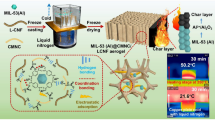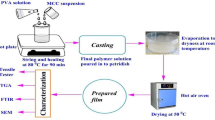Abstract
Recently, nanosized cellulose materials extraction is extensively interesting from the sources of sustainable materials. Cellulose nanofibrils (CNF) extraction through green bio-based materials featured as promising interest in the field of science. In this study, dimethyl sulfoxide (DMSO) was applied to examine its effectiveness in pretreating the Ficus natalensis barkcloth cellulose (FNBC) for CNF production before 2,2,6,6,-tetramethylpiperidine-1-oxyl (TEMPO) oxidation. The pretreatment performance of DMSO was evaluated based on the structural and morphological changes. DMSO pretreated FNBC attained the most dramatic morphological changes as compared to untreated cellulose samples. The results of the scanning electron microscope (SEM) and transmission electron microscope (TEM) shows that there is an extensive structural disruption of FNBC during the pretreatment process, which could be because of outstanding ability to eliminate non-cellulosic materials and amorphous regions from the FNBC, confirmed by the X-ray diffractometry (XRD) showing higher crystallinity values, as well as higher thermal stabilities values of pretreated FNBC samples, were also noted. Overall, this study revealed a tremendously effective and pioneer pretreatment method for fractionating FNBC, to stimulate the successive extraction of cellulose nanofibrils. Furthermore, based on the cellulose and CNF characterizations, this study showed that F. natalensis barkcloth could be considered as an alternative source of cellulose for potential value-added industrial applications such as the food industry, paper making, and biomedicines.
Graphic Abstract









Similar content being viewed by others
References
P. Huang, Y. Zhao, S. Kuga, M. Wu, and Y. J. N. Huang, "A versatile method for producing functionalized cellulose nanofibers and their application," vol. 8, no. 6, pp. 3753–3759, 2016.
Frone AN, Chiulan I, Panaitescu DM, Nicolae CA, Ghiurea M, Galan A-MJML (2017) Isolation of cellulose nanocrystals from plum seed shells, structural and morphological characterization. Matteer Lett. 194:160–163
K. Ramanaiah, A. R. Prasad, K. H. C. J. M. Reddy, and Design, "Mechanical, thermophysical and fire properties of sansevieria fiber-reinforced polyester composites," Mater Design. 49, 986–991, 2013.
E. A. Hassan, M. L. Hassan, R. E. Abou-Zeid, N. A. J. I. C. El-Wakil, and Products, Novel nanofibrillated cellulose/chitosan nanoparticles nanocomposites films and their use for paper coating. Ind Crops Prod. 93, 219–226, 2016.
Fukuzumi H, Saito T, Iwata T, Kumamoto Y, Isogai A (2008) Transparent and high gas barrier films of cellulose nanofibers prepared by TEMPO-mediated oxidation. Biomacromol 10(1):162–165
Saito T, Shibata I, Isogai A, Suguri N, Sumikawa N (2005) Distribution of carboxylate groups introduced into cotton linters by the TEMPO-mediated oxidation. Carbohyd Polym 61(4):414–419
Li Y et al (2016) Facile extraction of cellulose nanocrystals from wood using ethanol and peroxide solvothermal pretreatment followed by ultrasonic nanofibrillation. Green Chem 18(4):1010–1018
Rajinipriya M, Nagalakshmaiah M, Robert M, Elkoun S (2018) Importance of agricultural and industrial waste in the field of nanocellulose and recent industrial developments of wood based nanocellulose: a review. ACS Sustainable Chemistry & Engineering 6(3):2807–2828
Shak KPY, Pang YL, Mah SK (2018) Nanocellulose: Recent advances and its prospects in environmental remediation. Beilstein J Nanotechnol 9(1):2479–2498
Sirviö JA, Visanko MJJOMCA (2017) "Anionic wood nanofibers produced from unbleached mechanical pulp by highly efficient chemical modification. Carbohydrate Poly 5:21828–21835
Tabar IB, Zhang X, Youngblood JP, Mosier NSJCP (2017) Production of cellulose nanofibers using phenolic enhanced surface oxidation. Carbohydrate Poly 174:120–127
Ebringerová A, Heinze TJMRC (2000) Xylan and xylan derivatives–biopolymers with valuable properties, 1 Naturally occurring xylans structures, isolation procedures and properties. Macromol Rapid Commun 21:542–556
F. Xu et al., "Fractional separation of hemicelluloses and lignin in high yield and purity from mild ball-milled Periploca sepium," vol. 43, no. 11–12, pp. 3351–3375, 2008.
Sun R, Tomkinson JJIJOPA (2003) Fractional isolation and spectroscopic characterization of sago starch. Int J Poly Anal Char. 8:29–46
Pramanik MM, Rastogi N (2016) Visible light catalyzed methylsulfoxidation of (het) aryl diazonium salts using DMSO. Chem Commun 52(55):8557–8560
Höije A, Gröndahl M, Tømmeraas K, Gatenholm PJCP (2005) Isolation and characterization of physicochemical and material properties of arabinoxylans from barley husks. Carbohydrate Poly 61:266–275
Singh D, Singh B, Goel RK (2011) Traditional uses, phytochemistry and pharmacology of Ficus religiosa: A review. J Ethnopharmacol 134(3):565–583
Serrato A, Ibarra-Manríquez G, Oyama K (2004) Biogeography and conservation of the genus Ficus (Moraceae) in Mexico. J Biogeogr 31(3):475–485
Awolola GV, Chenia H, Baijnath H, Koorbanally NA (2017) Anti-adhesion potential of non-polar compounds and extracts from Ficus natalensis. Rev Bras 27(5):599–602
Y. Kim and V. Chalivendra, "Handbook of Natural Fibres," Natural fibre composites (NFCs) for construction and automotive industries, pp. 469–498, 2020.
A. Hutchings, Zulu medicinal plants: An inventory. University of Natal press, 1996.
Rwawiire S, Tomkova B, Militky J, Jabbar A, Kale BM (2015) Development of a biocomposite based on green epoxy polymer and natural cellulose fabric (bark cloth) for automotive instrument panel applications. Compos B Eng 81:149–157
D. Cousins and M. A. J. A. S. M. Huffman (2002) Medicinal properties in the diet of gorillas: an ethno-pharmacological evaluation, 23, 65–89.
Rwawiire S, Tomkova B, Militky J, Hes L, Kale BM (2017) Acoustic and thermal properties of a cellulose nonwoven natural fabric (barkcloth). Appl Acoust 116:177–183
Rwawiire S, Tomkova B, Wiener J, Militky J (2016) Effect of enzyme and plasma treatments of bark cloth from Ficus natalensis: morphology and thermal behavior. J Textile Institute 107(5):663–671
Rwawiire S, Luggya GW, Tomkova B (2013) Morphology, thermal, and mechanical characterization of bark cloth from Ficus natalensis. ISRN Textiles 2013:1–8
Mugaanire IT, Wang H, Sun J (2019) Fibrous microcrystalline cellulose from Ficus natalensis barkcloth. European J Wood Wood Products 77(3):483–486
A. Farooq, S. Jiang, A. Farooq, M. A. Naeem, A. Ahmad, and L. Liu (2019) Structure and properties of high quality natural cellulose nano fibrils from a novel material Ficus natalensis barkcloth. Journal of Industrial Textiles, p. 1528083719887533.
S. Rwawiire, N. Catherine, K. S. Baker, and G. Davis (2012) Processing of natural fiber textile from Ficus natalensis and Antiaris toxicaria," in Proceedings of the 2nd International Symposium on Sustainable Development through Research in Natural Textile Fibers, Textile Products, Trade and Marketing.
L. Costa, A. F. Fonseca, F. V. Pereira, and J. I. J. C. C. T. Druzian (2015) Extraction and characterization of cellulose nanocrystals from corn stover. 49, 127–133.
Shaheen TI, Emam HE (2018) Sono-chemical synthesis of cellulose nanocrystals from wood sawdust using acid hydrolysis. Int J Biol Macromol 107:1599–1606
Isogai A, Kato Y (1998) Preparation of polyuronic acid from cellulose by TEMPO-mediated oxidation. Cellulose 5(3):153–164
Adeeyo O, Oresegun OM, Oladimeji TE (2015) Compositional analysis of lignocellulosic materials: Evaluation of an economically viable method suitable for woody and non-woody biomass. Am J Eng Res (AJER) 4(4):14–19
Segal L, Creely J, Martin A Jr, Conrad C (1959) An empirical method for estimating the degree of crystallinity of native cellulose using the X-ray diffractometer. Text Res J 29(10):786–794
Saito T, Isogai A (2004) TEMPO-mediated oxidation of native cellulose. The effect of oxidation conditions on chemical and crystal structures of the water-insoluble fractions. Biomacromol 5(5):1983–1989
Saito T, Isogai A (2005) Ion-exchange behavior of carboxylate groups in fibrous cellulose oxidized by the TEMPO-mediated system. Carbohyd Polym 61(2):183–190
Das K et al (2010) Physicomechanical and thermal properties of jute-nanofiber-reinforced biocopolyester composites. Ind Eng Chem Res 49(6):2775–2782
Penjumras P, Rahman RBA, Talib RA, Abdan KJA, Procedia AS (2014) Extraction and characterization of cellulose from durian rind. Agri Agri Sci Procedia. 2:237–243
Okita Y, Fujisawa S, Saito T, Isogai A (2010) TEMPO-oxidized cellulose nanofibrils dispersed in organic solvents. Biomacromol 12(2):518–522
Johar N, Ahmad I, Dufresne A (2012) Extraction, preparation and characterization of cellulose fibres and nanocrystals from rice husk. Ind Crops Prod 37(1):93–99
Isogai A, Saito T, Fukuzumi H (2011) TEMPO-oxidized cellulose nanofibers. Nanoscale 3(1):71–85
Benhamou K, Dufresne A, Magnin A, Mortha G, Kaddami H (2014) Control of size and viscoelastic properties of nanofibrillated cellulose from palm tree by varying the TEMPO-mediated oxidation time. Carbohyd Polym 99:74–83
Miao X, Lin J, Tian F, Li X, Bian F, Wang J (2016) Cellulose nanofibrils extracted from the byproduct of cotton plant. Carbohyd Polym 136:841–850
Haafiz MM, Hassan A, Zakaria Z, Inuwa I (2014) Isolation and characterization of cellulose nanowhiskers from oil palm biomass microcrystalline cellulose. Carbohyd Polym 103:119–125
Fukuzumi H, Saito T, Okita Y, Isogai A (2010) Thermal stabilization of TEMPO-oxidized cellulose. Polym Degrad Stab 95(9):1502–1508
Zhai L, Kim HC, Kim JW, Choi ES, Kim J (2018) Cellulose nanofibers isolated by TEMPO-oxidation and aqueous counter collision methods. Carbohyd Polym 191:65–70
Kim H-S, Kim S, Kim H-J, Yang H-S (2006) Thermal properties of bio-flour-filled polyolefin composites with different compatibilizing agent type and content. Thermochim Acta 451(1–2):181–188
Spinella S et al (2016) Concurrent cellulose hydrolysis and esterification to prepare a surface-modified cellulose nanocrystal decorated with carboxylic acid moieties. ACS Sustainable Chemistry & Engineering 4(3):1538–1550
Mandal A, Chakrabarty D (2011) Isolation of nanocellulose from waste sugarcane bagasse (SCB) and its characterization. Carbohyd Polym 86(3):1291–1299
B. Deepa et al., "Structure, morphology and thermal characteristics of banana nano fibers obtained by steam explosion," vol. 102, no. 2, pp. 1988–1997, 2011.
Ouajai S, Shanks RJPD (2005) Composition, structure and thermal degradation of hemp cellulose after chemical treatments. Poly Degradation Stability. 89:327–335
Fukuzumi H, Saito T, Iwata T, Kumamoto Y, Isogai AJB (2009) Transparent and high gas barrier films of cellulose nanofibers prepared by TEMPO-mediated oxidation. Biomacromol 10:162–165
Jakob H, Fratzl P, Tschegg S (1994) Size and arrangement of elementary cellulose fibrils in wood cells: a small-angle X-ray scattering study of Picea abies. J Struct Biol 113(1):13–22
De Nooy A, Besemer AC, Van Bekkum H, Van Dijk J, Smit J (1996) TEMPO-mediated oxidation of pullulan and influence of ionic strength and linear charge density on the dimensions of the obtained polyelectrolyte chains. Macromolecules 29(20):6541–6547
Ye W, Liu L, Wang Z, Yu J, Fan Y (2019) Investigation of pretreatment methods for improving TEMPO-mediated oxidation and nanofibrillation efficiency of α-chitin. ACS Sustain Chem Eng 7(24):19463–19473
Acknowledgements
The authors would like to mention the financial support for the research, authorship, and/or publication of this article
Funding
The work was supported by “National Key R&D Program of China (2018YFC2000900)” and “Suzhou Science and Technology Project (ZXL2018134)”.
Author information
Authors and Affiliations
Corresponding author
Additional information
Publisher's Note
Springer Nature remains neutral with regard to jurisdictional claims in published maps and institutional affiliations.
Supplementary Information
Below is the link to the electronic supplementary material.
Rights and permissions
About this article
Cite this article
Farooq, A., Li, M., Alasood, A. et al. Novel Pretreatment Performance Evaluation for Cellulose Nanofibrils Extraction from Ficus natalensis Barkcloth. J Polym Environ 30, 1547–1559 (2022). https://doi.org/10.1007/s10924-021-02297-x
Accepted:
Published:
Issue Date:
DOI: https://doi.org/10.1007/s10924-021-02297-x




